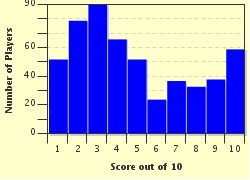Quiz Answer Key and Fun Facts
1. The diagram shows a unit circle, which means its radius is 1 unit long. The large dot shows the location of a point P which can move along the path of the circle. As it moves, its x- and y-coordinates change. We will measure how far it has travelled along the circle's circumference as t, and describe how the coordinates change as it moves. What are the coordinates of the point P at the start, when t=0?
2. This diagram shows the point P shortly after it has started moving in an anti-clockwise direction around a unit circle. It has covered a distance t, and its coordinates are (x,y). Lines have been added to show how P can be considered to be at one corner of a right-angled triangle whose horizontal leg is x units long, and whose vertical leg is y units long. Remembering that the circle has a radius of 1, and using the standard definitions of trigonometric ratios, which of the following is an algebraic expression for the cosine of the angle that this triangle forms at the centre of the circle (the angle marked with a small symbol)?
3. The sine function can be defined as the y-coordinate of a point moving around a unit circle (circle whose radius is 1) in an anti-clockwise direction. This graph of y = sin(t) can be seen to repeat itself after an interval called its period. As shown in the graph, which of these is closest to the period of this function?
4. The value of the sine function changes smoothly between two extreme values. The magnitude of its largest value is called the amplitude of the function. As shown in the graph, which of these is closest to the amplitude of the function y = sin(t)?
5. By comparing the graphs for y = sin(t) and y = 2sin(t), what can be concluded about the probable shape of any graph y = Asin(t), where A is a positive number?
6. By comparing the graphs for y = sin(t) and y = -sin(t), what can be concluded about the effect of multiplying the function values by -1?
7. By comparing the graphs for y = sin(t), y = sin(2t) and y = sin(0.5t), what can you conclude about the probable shape of the graph of y = sin(nt), where n is a real number?
8. By comparing the graphs for y = sin(t) and y = sin(t) +2, what can you conclude about the probable shape of the graph of y = sin(t) + k, where k is a positive number?
9. By comparing the graphs of y = sin(t) and y = sin(t-2), what can you conclude about the probable shape of the graph of y = sin(t-h), where h is a positive number?
10. By comparing the graphs of y = sin(t) and y = sin(-t), how could their relationship be described?
Source: Author
looney_tunes
This quiz was reviewed by FunTrivia editor
crisw before going online.
Any errors found in FunTrivia content are routinely corrected through our feedback system.

